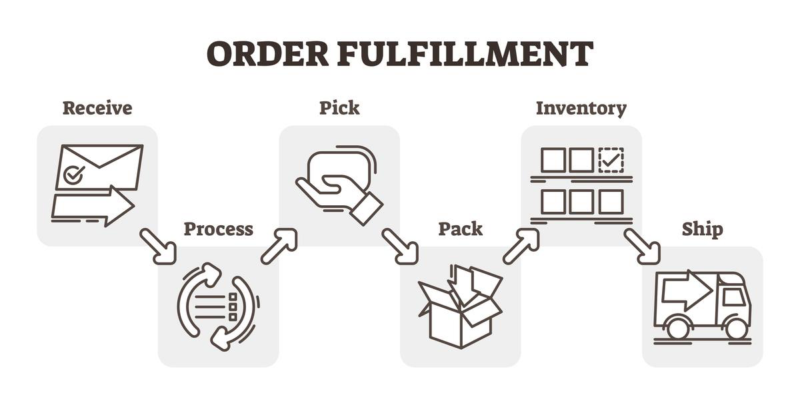
Optimizing Your Business with an Order Fulfillment Process Flow Chart

Importance of Efficient Order Fulfillment in Business Growth
Efficient order fulfillment plays a vital role in the growth and success of any business, particularly in the ecommerce industry. It encompasses the entire process from receiving an order to delivering the product to the customer’s doorstep. By ensuring a seamless and optimized order fulfillment process, businesses can enhance customer satisfaction, improve operational efficiency, and drive growth.
Overview of Order Fulfillment Process Flow Chart
An order fulfillment process flow chart provides a visual representation of the steps involved in fulfilling customer orders. It serves as a roadmap for businesses to streamline their operations, improve order accuracy, and enhance overall efficiency. By utilizing a process flow chart template, businesses can map out their inventory management, order picking, packing, and shipping processes, ensuring a systematic and error-free approach.
Understanding the Order Fulfillment Process
1. Definition and key components of the order fulfillment process
The order fulfillment process encompasses a series of interconnected activities that take place once a customer places an order. It typically involves order processing operations, such as order entry and validation, inventory management, order picking, efficient order packing, and quality control checks. These components ensure that each order is fulfilled accurately and in a timely manner.
2. Objectives of an optimized order fulfillment process
The primary objectives of an optimized order fulfillment process are to ensure speed and accuracy in order processing, minimize errors and delays, and enhance the overall customer experience. By implementing efficient workflows and utilizing flow charts, businesses can streamline their supply chain, reduce fulfillment challenges, and improve customer satisfaction.
3. Common challenges faced in order fulfillment
Order fulfillment can pose various challenges for businesses. Some common challenges include inventory management issues, inefficient order picking and packing processes, fulfillment accuracy concerns, and the need for effective communication and collaboration across multiple departments. By addressing these challenges, businesses can enhance their order fulfillment experience and drive growth.
Benefits of Implementing a Process Flow Chart

1. Enhanced visibility and control over the fulfillment process
By implementing a process flow chart, businesses gain improved visibility and control over their order fulfillment process. They can track orders at each stage, identify bottlenecks, and make necessary adjustments to ensure efficient and timely order processing.
2. Improved accuracy and reduced errors
A process flow chart helps businesses standardize their order fulfillment procedures, minimizing errors and improving accuracy. By clearly defining the steps involved, businesses can ensure that each order is fulfilled correctly, reducing the risk of incorrect shipments or damaged goods.
3. Streamlined communication and collaboration
The use of workflows and flow charts facilitates streamlined communication and collaboration among different teams and departments involved in the order fulfillment process. Clear guidelines and responsibilities outlined in the flow chart help eliminate confusion and enhance coordination, leading to more efficient operations.
4. Efficient resource allocation and cost savings
An optimized order fulfillment process flow chart allows businesses to allocate resources effectively. By identifying bottlenecks and inefficiencies, businesses can make informed decisions regarding staffing, equipment, and inventory management, leading to cost savings and improved resource utilization.
Creating an Order Fulfillment Process Flow Chart

1. Identifying key stages and activities in the process
The first step in creating an order fulfillment process flow chart is to identify the key stages and activities involved. These stages may include order entry and validation, inventory management, picking, packing, shipping, quality control, delivery, and returns and exchange management. By clearly defining each stage, businesses can better understand the flow of their order fulfillment process.
2. Mapping out the sequential flow of activities
Once the key stages are identified, the next step is to map out the sequential flow of activities. This involves determining the order in which each activity occurs and visualizing the flow from one stage to another. By mapping out the sequence, businesses can identify potential bottlenecks and optimize the flow to improve efficiency.
3. Including decision points and alternative paths
An effective order fulfillment process flow chart should also consider decision points and alternative paths. These decision points arise when certain conditions or criteria need to be met before proceeding to the next stage. Including alternative paths allows for flexibility in handling exceptions or variations in the process, such as rush orders or customizations.
4. Defining inputs, outputs, and responsibilities for each step
To ensure clarity and accountability, it is important to define the inputs, outputs, and responsibilities for each step in the order fulfillment process. This includes identifying the information or materials required at each stage, the expected outcomes or deliverables, and the individuals or departments responsible for carrying out the activities.
Key Components of an Effective Order Fulfillment Process Flow Chart

1. Order entry and validation
The order entry and validation stage is where businesses receive an order from a customer. This typically involves capturing relevant customer information, verifying the order details, and checking for availability of the requested products.
2. Inventory management and product availability
Once an order is received and validated, the inventory management stage comes into play. Businesses must ensure that the ordered products are in stock and available for fulfillment. This step involves monitoring inventory levels, restocking when necessary, and managing SKU (stock-keeping unit) information.
3. Picking, packing, and shipping
The picking, packing, and shipping stage involves physically retrieving the ordered products from their location in the distribution center or warehouse, packing them securely, and preparing them for shipment. This can be done by a dedicated picking team or automated systems to expedite the process.
4. Quality control and inspection
To maintain customer satisfaction and minimize returns, quality control checks should be performed. This stage ensures that the products are in good condition, meet the required standards, and are ready for shipment. Any damaged goods or quality issues are identified and addressed appropriately.
5. Delivery and tracking
Once the products are packed and ready for shipment, they are handed over to the chosen transportation channel for delivery. This stage involves coordinating with logistics providers, selecting the most suitable carrier, and generating tracking information to enable customers to track their orders.
6. Returns and exchange management
Returns processing is a critical component of the order fulfillment process. In this stage, businesses handle customer returns, exchanges, or refunds. Efficient returns management helps resolve customer issues promptly, reduces supply chain costs, and maintains overall customer satisfaction.
Implementing and Optimizing the Process Flow Chart

1. Assigning roles and responsibilities
To ensure smooth execution of the order fulfillment process, it is essential to assign clear roles and responsibilities to individuals or departments involved. This helps in establishing accountability and streamlining communication throughout the process.
2. Training employees on the new process
When implementing a new order fulfillment process, proper training is crucial. Employees should be familiarized with the revised workflow, their specific responsibilities, and any changes in the technology or automation tools being utilized. Training ensures a smooth transition and empowers employees to perform their tasks effectively.
3. Incorporating technology and automation
Technology and automation can significantly enhance the efficiency and accuracy of the order fulfillment process. Integration of an order management system, inventory management software, and automated picking and packing systems can minimize errors, streamline operations, and expedite order processing.
4. Monitoring and measuring performance metrics
Monitoring and measuring performance metrics provide valuable insights into the effectiveness of the order fulfillment process. Key metrics to track include order cycle time, order accuracy, on-time delivery, returns processing time, and customer satisfaction. Regular analysis of these metrics helps identify areas for improvement.
5. Continuously improving the process
The order fulfillment process is not static, and businesses should strive for continuous improvement. By encouraging feedback from employees, customers, and stakeholders, businesses can identify bottlenecks, inefficiencies, or emerging challenges and implement necessary adjustments to enhance the process further.
More Information
Field Service Software: Streamlining and Optimizing Operations for Small Businesses
Field service software is a technology solution that aims to streamline and optimize field service operations for small businesses in various industries. With the advancement of technology, many field service industries have embraced online software solutions to enhance their efficiency and productivity. ServiceFolder (www.servicefolder.com) is one such online software specifically designed for field service companies.
Industries Benefiting from Field Service Software
Field service software has proven to be beneficial for a wide range of industries. Some notable examples include:
HVAC
Heating, ventilation, and air conditioning (HVAC) companies can utilize field service software to manage their service calls, track equipment maintenance, and ensure timely repairs and installations.
Appliance Repair
Appliance repair businesses can benefit from field service software by efficiently scheduling appointments, managing inventory, and providing real-time updates to customers about the status of their repairs.
Chimney Sweep
Chimney sweep companies can utilize field service software to track their service history, schedule appointments, and manage customer communications for better customer service.
Cleaning Business
Field service software can assist cleaning businesses in managing their workforce, tracking cleaning schedules, and ensuring efficient communication between staff and clients.
Contractor Business
Contractor businesses, such as construction and renovation companies, can streamline their operations by using field service software to manage project timelines, assign tasks, and track expenses.
Electrician Business
Electrician businesses can benefit from field service software by efficiently managing work orders, tracking inventory, and ensuring timely response to customer requests.
Handyman
Handyman services can utilize field service software to manage their appointments, track customer requests, and streamline their billing process for improved efficiency.
Plumbing
Plumbing companies can optimize their operations by using field service software to manage their service calls, track inventory, and streamline their workflow for faster response times.
ServiceFolder’s Blogs and Resources
ServiceFolder not only provides an online software solution but also offers informative blogs catered to various field service industries. These blogs cover a wide range of topics related to equipment maintenance, asset tracking, distributor field service software, and more. Some of the blog posts include:
- Asset Management in Field Service
- Asset Tracking and Field Maintenance
- Commercial Equipment Distributor Field Service Software
Additional Features of ServiceFolder
Apart from the blogs and resources, ServiceFolder offers several features to enhance field service operations, including:
- Field Service App: A mobile application that enables technicians to access job details, update work orders, and communicate with customers on the go.
- Field Service Contract Management: Efficient management of service contracts, renewals, and billing.
- Field Service CRM: Customer relati* Closing connection 0
- schannel: shutting down SSL/TLS connection with api.openai.com port 443 onship management tools to track customer interactions, manage leads, and improve customer satisfaction.
- Field Service Customer Equipment: A feature that allows businesses to track and manage customer equipment, warranties, and maintenance history.
- Field Service Customer Portal: A self-service portal for customers to schedule appointments, view service history, and communicate with the service provider.
In conclusion, field service software, exemplified by ServiceFolder, offers small businesses in various industries a comprehensive solution to streamline and optimize their operations. With specific features tailored to different field service industries and a wealth of informative blogs, ServiceFolder aims to empower businesses to achieve greater efficiency and customer satisfaction.
Conclusion
A well-designed and optimized order fulfillment process is vital for businesses looking to fulfill customer orders efficiently while minimizing errors and costs. By creating a comprehensive process flow chart and considering key components such as order entry and validation, inventory management, picking and packing, quality control, delivery and tracking, and returns management, businesses can streamline their operations and enhance customer satisfaction. Through proper implementation, training, and technology integration, along with continuous monitoring and improvement, businesses can achieve a seamless order fulfillment process that supports their growth and success in today’s competitive market.
Disclaimer: Some information is provided through AI. Users should always conduct their own research and consult with qualified professionals before making any decisions.Related Posts

Try Now
ServiceFolder's field service scheduling software free plan is perfect for small businesses with up to three people or less. It includes time tracking, scheduling, and mobile app features that make it one of the best mobile field service management software solutions for small businesses available. It is perfect for any small business company within the field service industry that wants to use technology to increase performance and productivity.